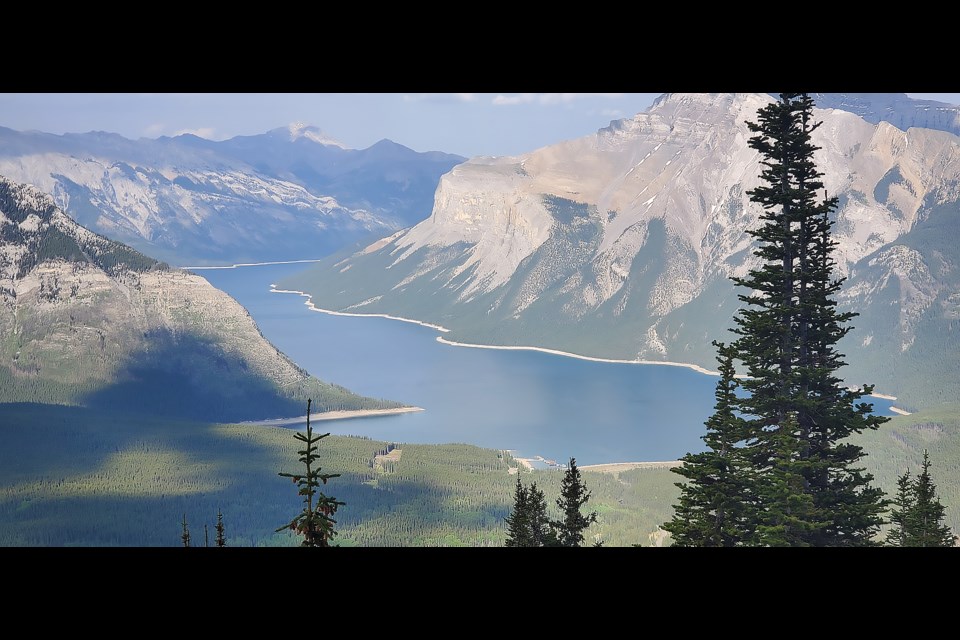BANFF – Banff’s Minnewanka Loop, an increasingly popular tourist hotspot in Banff National Park, was shut down for two hours on the busy summer weekend due to overcrowding and congestion.
Alberta 511 posted that the off-ramp of the Trans-Canada Highway at the Minnewanka turnoff was blocked off due to congestion on Saturday (July 22) as Parks Canada turned away traffic from the scenic loop road – the first time this has happened so far this summer.
Parks Canada officials say they closed the loop from about 2:15 p.m. until 4:15 p.m., as traffic backed up and vehicles parked illegally along the road in several locations, such as Two Jack Lake.
They say a plan and strategic environmental assessment for the Lake Minnewanka area – which hopes to tackle human use in the busy region of the park – is underway with hopes of being ready in 2024.
“The agency is currently in the process of planning for the public engagement portion of the project,” said Kira Tryon, public relations and communications officer for Banff National Park.
“Public engagement will be launched in the coming weeks, and more information will be shared at that time.”
Congestion levels on the Minnewanka Loop Road and in the main parking areas at Minnewanka, Johnson Lake and Two Jack Lake have been getting worse, particularly as day-trippers from growing Calgary continue to seek out the mountains.
It is estimated that roughly one-quarter of the national park’s annual visitation – about one million people – visit the Lake Minnewanka area. The Minnewanka area has seen traffic volumes increase by about 50 per cent over the past 10 years, with 75 per cent occurring between May and the end of September. Despite introduction of public transit to the area in recent years, most visitors still arrive in personal vehicles.
For decades, the western portion of the Minnewanka Loop road has been closed to vehicles during the winter months to allow wildlife to move undisturbed around the Norquay-Cascade corridor.
Bursting with paddlers, boaters, divers, hikers, bikers, campers, picnickers, stargazers, wildlife watchers and sightseers, the region is experiencing negative impacts, including people feeding wildlife, overflowing garbage bins and congestion.
Lake Minnewanka is also on the edge of one of three core areas for grizzly bears in Banff National Park, where a concentration of female grizzlies live and raise their cubs, and overall, the area is a wildlife hotspot.
Importantly, the region also contains a portion of the park’s rare montane ecoregion, which provides significant wildlife habitat to bears, bighorn sheep, wolves, cougars, and elk, and includes the Norquay-Cascade and the Two Jack wildlife corridors.
One of the biggest ecological concerns for the area is the chance of introducing aquatic invasive species into one of the lakes or streams, particularly because of the boom in water-based recreation such as paddle-boarding.
The Parks Canada-struck expert panel on moving people sustainably suggested various tourism hotspots in the park could be accessed by mass transit only.
At the annual planning forum in February, the park superintendent didn’t rule that out for the Minnewanka region in future, but indicated transit will continue and likely be enhanced.
The plan for the area will consider current and predicted levels and patterns of visitor use; trail, road, parking and other facility capacities; and a multi-use trail between Lake Minnewanka, campgrounds at Two Jack, Johnson Lake, Cascade Ponds and the Banff community.
It will also look at management of people in the event of an emergency, potential development and redevelopment proposals, and managing water-based activities and access to prevent the introduction of aquatic invasive species.
“Subject to environmental review of the plan, some reconfiguration of facilities and services within the area may be considered if it serves to address environmental and public safety issues, while improving visitor experience,” states the 2022 park management plan.
Meanwhile, Town of Banff officials say there was no additional negative traffic impact within the townsite due to the diversion away from the Minnewanka interchange on Saturday, but the Norquay entrance did have higher volumes coming into town.
“We had more than 30,000 vehicles counted at the entrances on Saturday, and anything over 24,000 means we are guaranteed to have traffic delays in town,” said Jason Darrah, the director of marketing and communications for the Town of Banff.
“I think our crews did a great job with manual overrides of traffic lights to help flush through congestion points, and our flaggers at key intersections on weekends are keeping vehicles and pedestrians moving safely.”
The traffic data on the Bow River Bridge and counters for traffic going to the gondola on Mountain Avenue show a decrease in volume, despite an increase in overall traffic coming into town.
Darrah said on the Saturday of the Minnewanka loop diversion, for example, there was a 13 per cent jump in traffic compared to the same time last year, and five per cent more vehicles than in pre-pandemic 2019.
Yet, he said, the traffic over the bridge on Saturday was down a full 14 per cent compared to 2019.
“We are seeing the benefits of our efforts to convince drivers to park at their hotels and campgrounds and take transit,” said Darrah.
“For day visitors, we have successfully communicated the importance to park in the free train station parking lot and walk or cycle downtown.”



